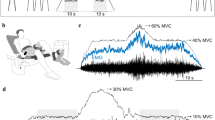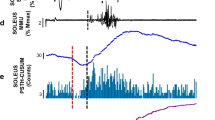Abstract.
Tendon jerk and H-reflexes are both potentiated by the Jendrassik manoeuvre, but the mechanism of potentiation remains uncertain. We investigated several possibilities in human subjects. Evidence for fusimotor activation during the Jendrassik manoeuvre was sought by recording the tendon jerk reflex as surface EMG in triceps surae after the muscles had been conditioned to leave their spindles in a slack, insensitive state. Interposing a Jendrassik manoeuvre between conditioning and the test reflex should have increased reflex amplitude by restoring spindle sensitivity, but this was not the case. In humans, a close synergist of the triceps surae is the quadriceps. A possible presynaptic disinhibitory mechanism was investigated by testing the effect of a Jendrassik manoeuvre on facilitation of the soleus H-reflex produced by a quadriceps afferent volley. The Jendrassik manoeuvre failed to increase facilitation, contrary to what would be expected if it reduced the level of tonic presynaptic inhibition; the assumption being that the inhibition acts on both homonymous and synergist afferent terminals. The Jendrassik manoeuvre did not increase the level of ongoing EMG in the soleus during a weak voluntary contraction, indicating that it does not operate by direct facilitation of motoneurones. There was found to be less potentiation of soleus tendon jerk and H-reflexes by the Jendrassik manoeuvre under conditions when spindles in the soleus were likely to have a high resting discharge rate. A remaining possibility is discussed: that the Jendrassik manoeuvre operates by modulation of oligosynaptic pathways that may contribute to the largely monosynaptic reflex response. These experiments demonstrate, with new, more sensitive methods than previously used, that neither is the fusimotor system involved in reinforcement nor are direct excitatory or presynaptic disinhibitory effects on motoneurones. While this confirms the previously prevailing view, none of the lingering uncertainties associated with the methods used now remains.
Similar content being viewed by others
Author information
Authors and Affiliations
Additional information
Electronic Publication
Rights and permissions
About this article
Cite this article
Gregory, .J., Wood, .S. & Proske, .U. An investigation into mechanisms of reflex reinforcement by the Jendrassik manoeuvre. Exp Brain Res 138, 366–374 (2001). https://doi.org/10.1007/s002210100707
Received:
Accepted:
Issue Date:
DOI: https://doi.org/10.1007/s002210100707




